|
The Institute of Circuit Technology Spring Seminar 25th Feb 2020 Pete Starkey |
|
 |
Back to Meriden, the nominal centre of England. The daffodils were blooming, although the weather was hardly spring-like: cold, blustery, and rivers bursting their banks. Some had to take substantial detours to avoid flooded roads, but members of the Institute of Circuit Technology (ICT) are robust and resilient! A good crowd made it to the seminar that followed the annual general meeting of the ICT, with five specialist presentations and excellent opportunities to network with their peers in the industry. |
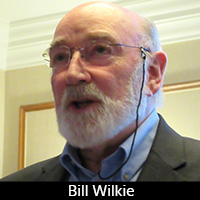 |
In his welcoming remarks, ICT Technical Director Bill Wilkie commented that the Institute continued to attract new members—membership currently totals over 400—and that the Annual Foundation Course remained an especially popular educational event, introducing the technology to generation after generation of printed circuit engineers and technicians. The Foundation Course had originated 40 years ago, organised by the Northern U.K. Printed Circuit Group, and held at the Hewlett-Packard facility in South Queensferry. He acknowledged the companies who continued to support the course and presented commemorative plaques to David Douglas, managing director of the Eurotech Group, and Neil Martin, chairman of the Merlin PCB Group. |
|
Chris Wall Technical Director Electra Polymers and Chemicals |
Wilkie had once more coordinated an excellent seminar agenda. He introduced as his first speaker Chris Wall, technical director at Electra Polymers, who gave a detailed review of the development and processing of an inkjettable solder mask and discussed the advantages of using it in PCB manufacturing. An understanding of the inkjet application process was the fundamental first step in the development programme, and Wall gave a brief introduction to the types of print-head available and how ink-drops were generated. This gave a good insight into the factors constraining the formulator, particularly the limited choice of suitable raw materials compared with those associated with conventional solder masks, restricted to very low viscosity resins and monomers and pigments with nanoscale particle sizes. Furthermore, it was necessary to keep filler content low or absent, which led to further challenges in achieving acceptable flammability, thermal shock, and solder resistance. Formulations also included flow agents, surface property modifiers, photoinitiators, and thermal curing agents. Optimum viscosity varied according to the type of print head, and—in combination with surface tension—affected jetting performance according to some complicated fluid dynamics where stable drop formation was a function of Reynolds number, Weber number, and Ohnesorge number. Wall did not dig too deeply into the physics. And once the ink hit the surface, its wetting characteristics and factors like contact angle affected spreading, bleed, and track-edge thinning, as well as the coating performance of any subsequent layers deposited. The curing mechanism depended on the resin chemistry, and inkjet formulations were generally pin-cured with UV during the printing operation to effectively set the image. A final thermal cure completed the crosslinking reaction. Once a test product had been formulated, it would initially be screen printed to assess its basic solder mask properties, and modified as necessary before being evaluated for its jetting performance and the properties of the jetted coating after curing. The sequence would be repeated as many times as necessary while the formulation was fine-tuned and optimised. Attributes—such as solder dam resolution, resistance to multiple solder reflow cycles, compatibility with plating chemistry, and conformal coatings—would be ascertained before submitting the final formulation for external testing for compliance with UL 94V0, RoHS, IPC-SM840, NASA specifications, etc., as well as automotive standards and individual customer requirements. Wall summarised the advantages of the inkjet process over the liquid photoimageable route, particularly in the elimination of the coating, drying stages, exposure and development stages, the savings in space, water and energy costs, and the lack of solvent emissions. There was no undercut at image edges, and—therefore—no risk of chemical or flux entrapment. He emphasised that inkjet solder mask relied on good surface preparation for adhesion, chemical resistance, and print quality. |
 |
A consequence of the continuing evolution of technology in the electronics industry was the production of e-waste from end-of-life equipment. It had been estimated that the U.K. produced over 500,000 tonnes annually of waste from electrical and electronic equipment (WEEE), of which over 40,000 tonnes originated from IT and telecoms equipment. Toxic components in WEEE could cause environmental problems if not properly managed; conversely, WEEE contained valuable metals that could potentially be recovered and recycled as raw materials. Indeed, in the case of printed circuit assemblies, the metal content of the waste was higher than in natural metal ores. For example, one tonne of WEEE could contain gold worth around £45,000. A current project at Coventry University focused on the recovery and recycling of metals from waste printed circuit assemblies as a step towards the circular economy and the sustainability of critical raw materials. Daniel Ray introduced the concept of “urban biomining” as an alternative to the traditional methods of recycling: pyrometallurgy—which involved high temperatures for pyrolysis or smelting—or hydrometallurgy—which utilised chemicals such as acids and cyanide. Neither was considered environmentally sustainable in today’s climate, and bioleaching had been identified as a way forward. |
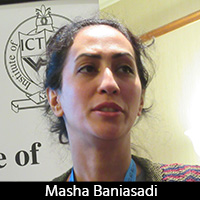 |
Biomining? Bioleaching? Science fiction? Dr. Mahsa Baniasadi explained that biomining offered a cost-effective and environmentally friendly option for leaching metals from ore using microorganisms to convert solid metals into aqueous species, and was already used to produce about 5% of the world’s gold and 20% of the world’s copper. The objective of urban biomining was to use spent electronics as the feedstock to make fresh electronic components, employing synthetically enhanced microbes to biologically extract specific metals. As an illustration of current recycling rates, a standard periodic table had been highlighted in different colours to indicate end-of-life recycling input. Copper, silver, and lead were all above 50%, but there was a very low input of many endangered elements. The natural sources of these elements were limited and not located in the U.K., so there was plenty of scope for recycling and sustaining the supply of critical raw materials. Dr. Baniasadi briefly explained the terminology and some of the mechanisms relevant to bioleaching; for example, redoxolysis referred to oxidation-reduction reactions catalysed by bacteria, acidolysis was the production of biogenic acid, and complexolysis was the production of biogenic complexing agents. She discussed iron oxidation, sulphur oxidation, and biogenic cyanide. Once a metal was in solution, electro-winning techniques could be used to deposit it in a relatively pure state. Daniel Ray described a process for gold bioleaching using thiourea—a less harmful alternative to biogenic cyanide, and indium bioleaching from display screens using an acidolysis bioleaching mechanism. Future work planned included reuse of materials, precious metal recovery, genetic modification of bacteria, and large-scale application of the technology. |
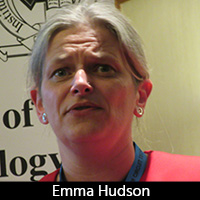 |
Newly appointed Chair of the ICT, Emma Hudson provided delegates with a comprehensive first-hand update on current IEC and UL standardisation work. The scope of IEC TC 91—the technical committee for electronics assembly technology—was to establish international acceptance for standards and guidelines in electronics assembly technology. ICT_Emma_Hudson200.jpgHudson is convenor of the IEC TC 91 working group responsible for preparing international standards on design, manufacturing, and testing of electronic assemblies—including the requirements and tests for materials and components used to manufacture circuit boards and electronic assemblies, as well as the formats of electronic data and libraries for describing these products and processes. She showed a long list of recent publications, with items of interest highlighted. There were 29 documents currently being worked on—24 new and five being revised, of which 20 were standards, and three were technical reports. Hudson is EIPC’s representative on the UL Standards Technical Panel for the UL 796, UL 796F, UL746E, and UL 746F standards. Probably the most relevant upcoming proposal from UL was to rename “solder limits” as “assembly soldering process” to provide a clearer interpretation of the significance of the parameter in representing the soldering processes the PCB would be exposed to during component assembly operations. New limits followed research from FED and ZVEI, and the proposed default condition would be six cycles of IPC-TM-2.6.27 T260 reflow, or a special reflow profile if agreed with the OEM or ODM. The reflow profile would be considered representative of wave and selective soldering, and UL’s follow-up service inspectors would check the maximum reflow temperature and the number of soldering cycles that the assembly was exposed to, but would not be checking details of the reflow profile beyond this. There was no plan to retrospectively apply the new assembly soldering process limits to existing board types—only to new evaluations, once the proposal had been accepted and added to UL 796, UL 746E, UL 796F, and UL 746F. And there was no guarantee that the proposal would be accepted by the UL Standards Technical Panel, although it was expected to happen with the coming 6–18 months. A significant new proposal presented at the UL Standards Technical Panel meeting came from Alun Morgan, representing Ventec. He suggested that the STP consider defining laminate groups by performance instead of nominal chemistry, to align with the industry and help designers in specifying their PCB requirements. |
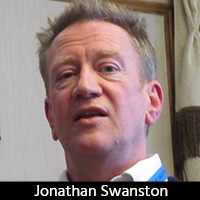 |
Dr. Jonathan Swanston, chief technical officer with Jiva Materials, gave an update on the ReCollect project, funded by Innovate U.K., and focused on the efficient manufacturing of recyclable composite laminates for electrical goods. Jiva Materials was one of three project partners—the others being Coventive Composites, an independent provider of expert services relating to composite materials, and the ICT, supporting dissemination and industry feedback. Jiva had developed the world's first fully recyclable PCB laminate. He passed around samples of his material, composed of a natural fibre bound with a polymer soluble in hot water but not in cold water, which had the appearance of a light-brown-coloured unclad laminate. Dr. Swanston reviewed some statistics which indicated that PCBs made up 8% of the 50 million tonnes of electronic waste that was generated in 2018. The ReCollect project explored an alternative way of managing end-of-life circuit boards. Currently, the only practical way of recycling glass-epoxy circuit boards involved shredding and incineration to recover the metal content. The ultimate aim of the project was to remove glass-epoxy boards from the supply chain, by demonstrating that Jiva’s Soluboard® could match the performance of CEM-1 and FR-4 materials. Dr. Swanston explained that Soluboard was a fully biodegradable and non-toxic product based on flax. A primary aim of the project was to demonstrate the feasibility of producing the material in high volumes at a competitive price, using a continuous-production process in development by Coventive Composites. The nature of Soluboard® was to delaminate when immersed into hot water, enabling the flax fibres to be composted or repurposed and the electronic components to be removed for reprocessing. Silver printing was a feasible method for creating functional circuits. But to use existing aqueous manufacturing processes, it was necessary to seek a means of chemically protecting the material in-process, and this was part of the project. Dr. Swanston commented that “white goods”—large household appliances—constituted more than 30% of e-waste, and that the Global E-Waste Monitor had reported that less than 20% of this was documented as collected and recycled. The rest went to landfill. Jiva intended to push for the safe recovery of e-waste in line with the WEEE2 Directive. The white goods market was their initial target, and specifications from potential customers had defined electrical, flammability, and mechanical requirements. Soluboard® had a Tg of 126°C and a UL94V0 flammability rating. Its electrical properties were being determined by a third-party laboratory, and final results were awaited. As part of the project, functioning populated PCBs would be designed, manufactured, and evaluated as specified by end customers. |
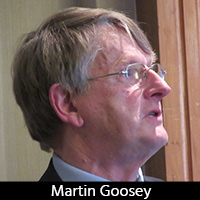 |
Government policy clearly aims to end the sale of new diesel and petrol cars by the year 2035 and compel the mass adoption of electric vehicles. The cost of the battery currently represents a significant proportion of the overall cost of an electric vehicle; the battery gradually loses its capacity and is typically replaced when it drops to below 70–80% of the original. The first generation of vehicle batteries are reaching end-of-life now, and volumes are set to increase significantly. To reuse in secondary applications or to recycle to recover raw materials were questions explored in an informative presentation from Professor Martin Goosey. In the context of a circular economy, it made sense to reuse and then recycle, but both possibilities had some merits. The number of end-of-life vehicle batteries was predicted to grow from 55,000 in 2018 to 3.4 million by 2025 and 6.0 million by 2030, and this represented around 275 gigawatt-hours of capacity. Should electric vehicle batteries be used for home energy storage, and was this an economic proposition for the average user? Tesla, for example, manufactured rechargeable lithium-ion batteries for stationary energy storage but preferred to recycle its used batteries. Although there were several nominal benefits of reusing vehicle batteries, the negatives included transport costs and the costs of dismantling, testing, reassembly, and certification. There were many different types of battery chemistry and size, and although reuse would nominally extend the life, the batteries would ultimately need recycling anyway. The need to balance power availability was becoming more important with the growth of electricity generation from intermittent sources; for instance, the solar industry heavily depended on the cost-effective integration of appropriate energy storage systems. Battery performance was continuously improving, and new battery costs were reducing. The example quoted by Professor Goosey indicated that the cost per kilowatt-hour in 2020 was 20% of the 2010 figure, projected to fall to 10% by 2030. Why not just use new batteries and simply recycle the old ones? The best route was still to be determined. However, with the move to electric vehicles being accelerated by government policy, it would be vitally important that the correct decisions were taken. Click here to view PDF presentation Professor Goosey wrapped-up the proceedings, thanking all of the participants. He also gave a special thanks to Bill Wilkie for his superb organisation and management of the event. |
| Reproduced by kind permission of I-Connect007.
Pete Starkey February 2020 |

